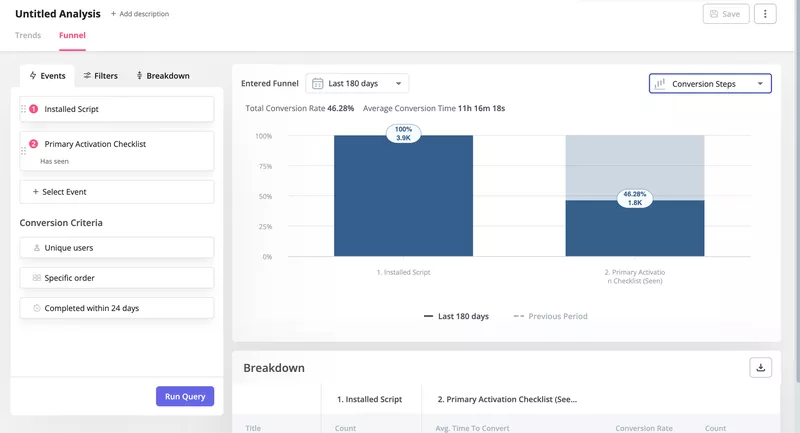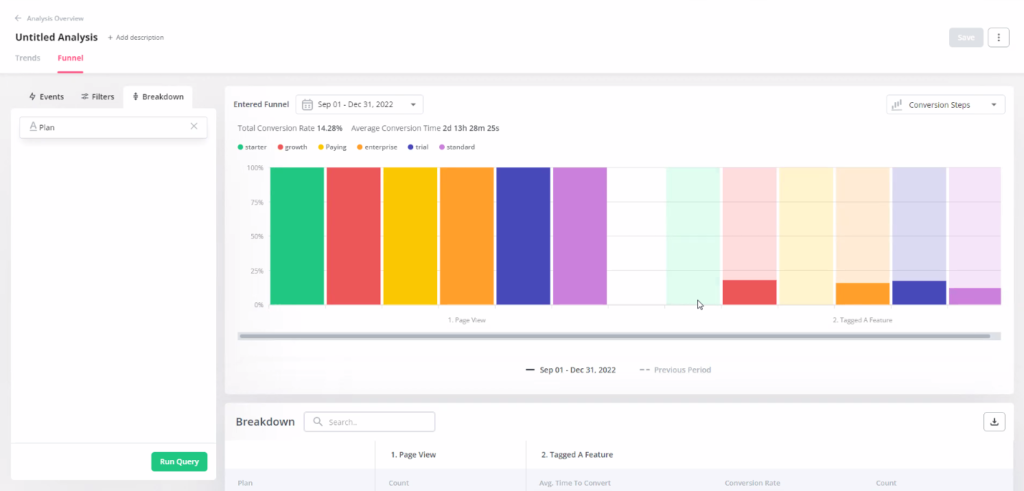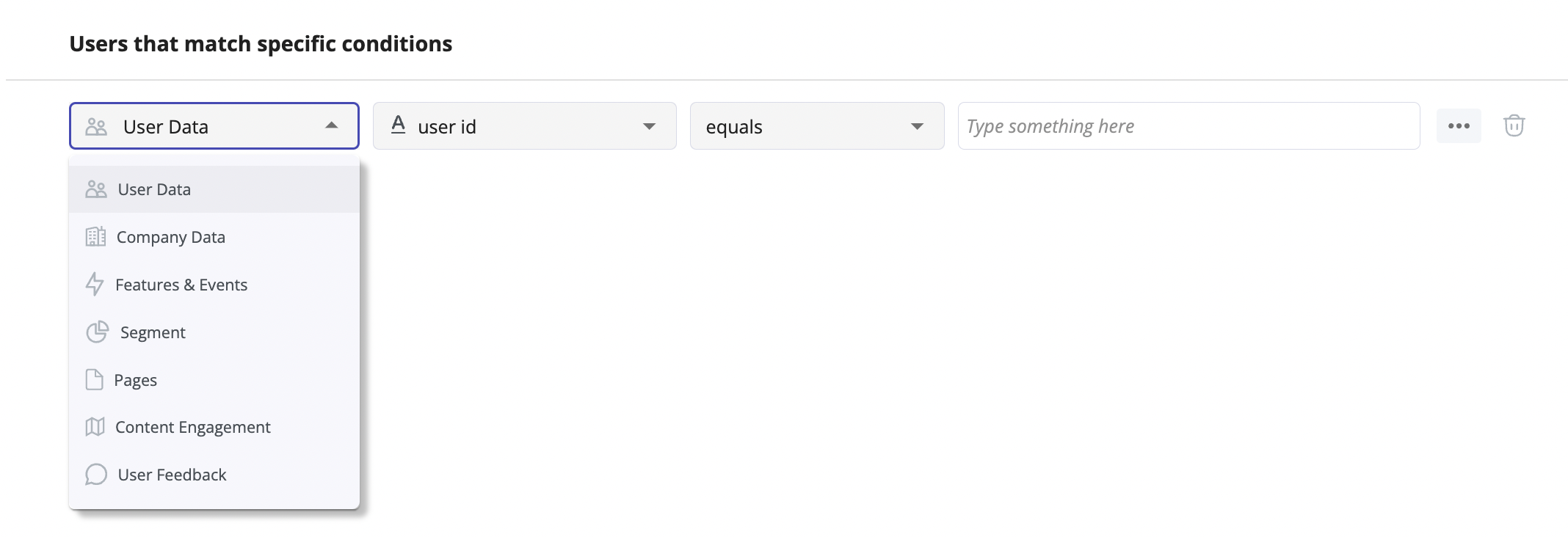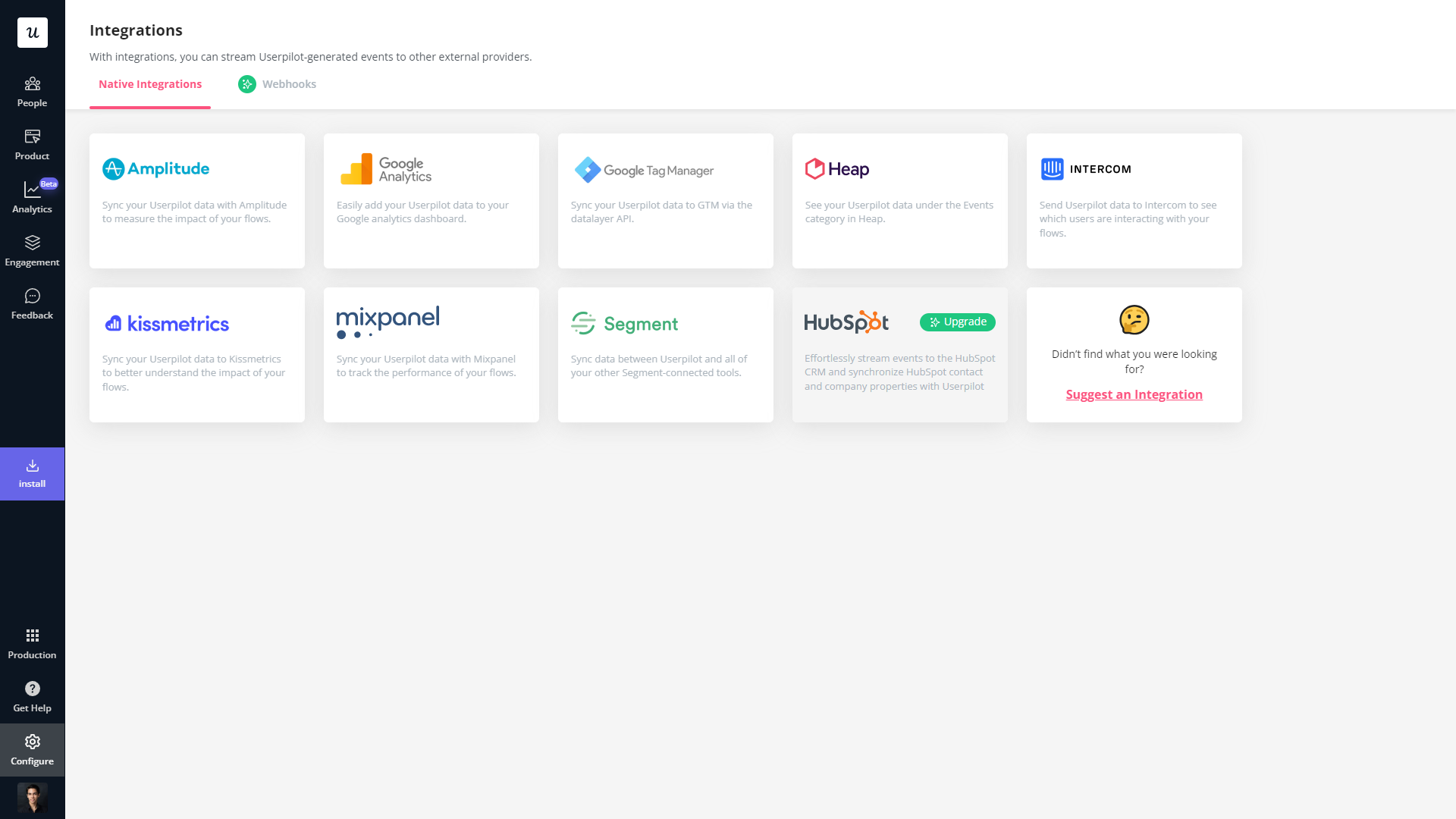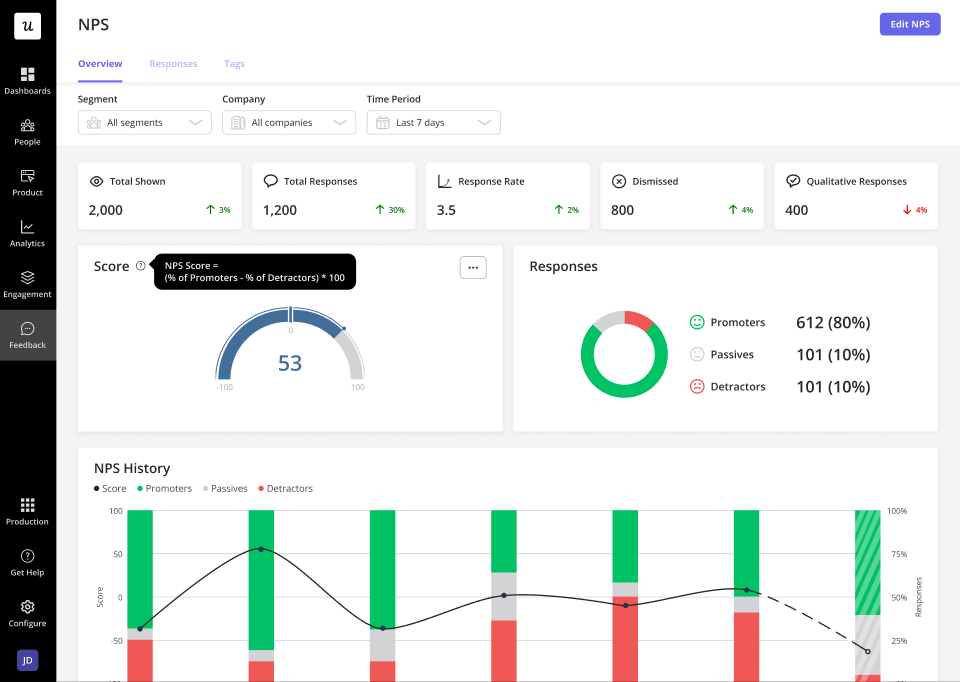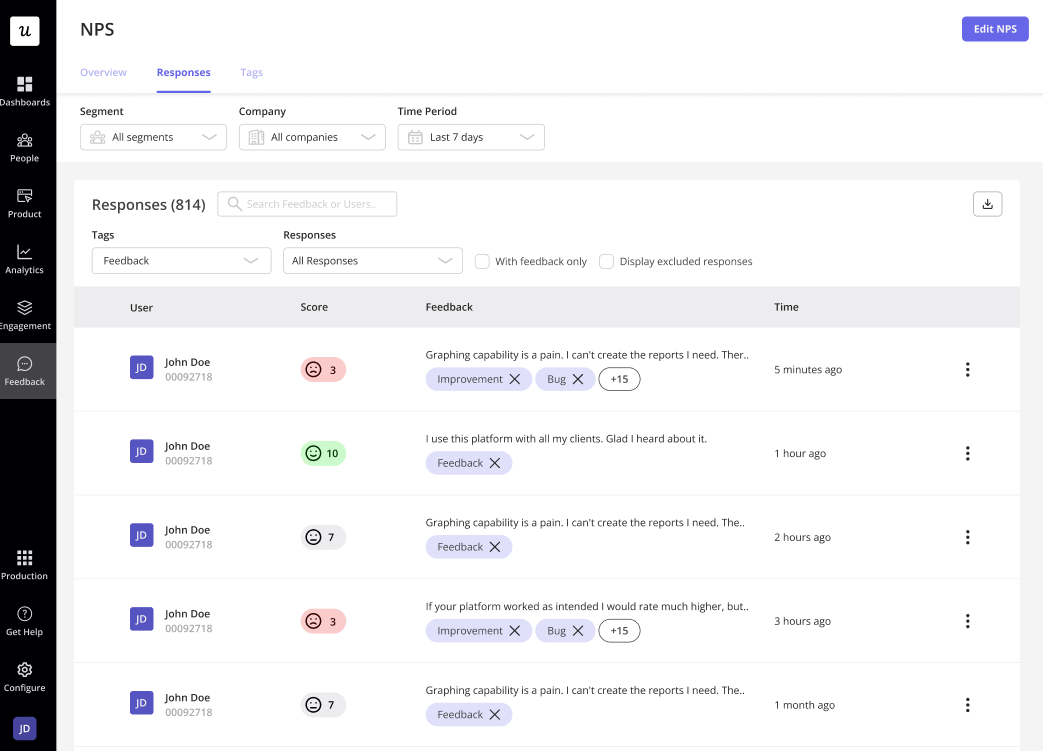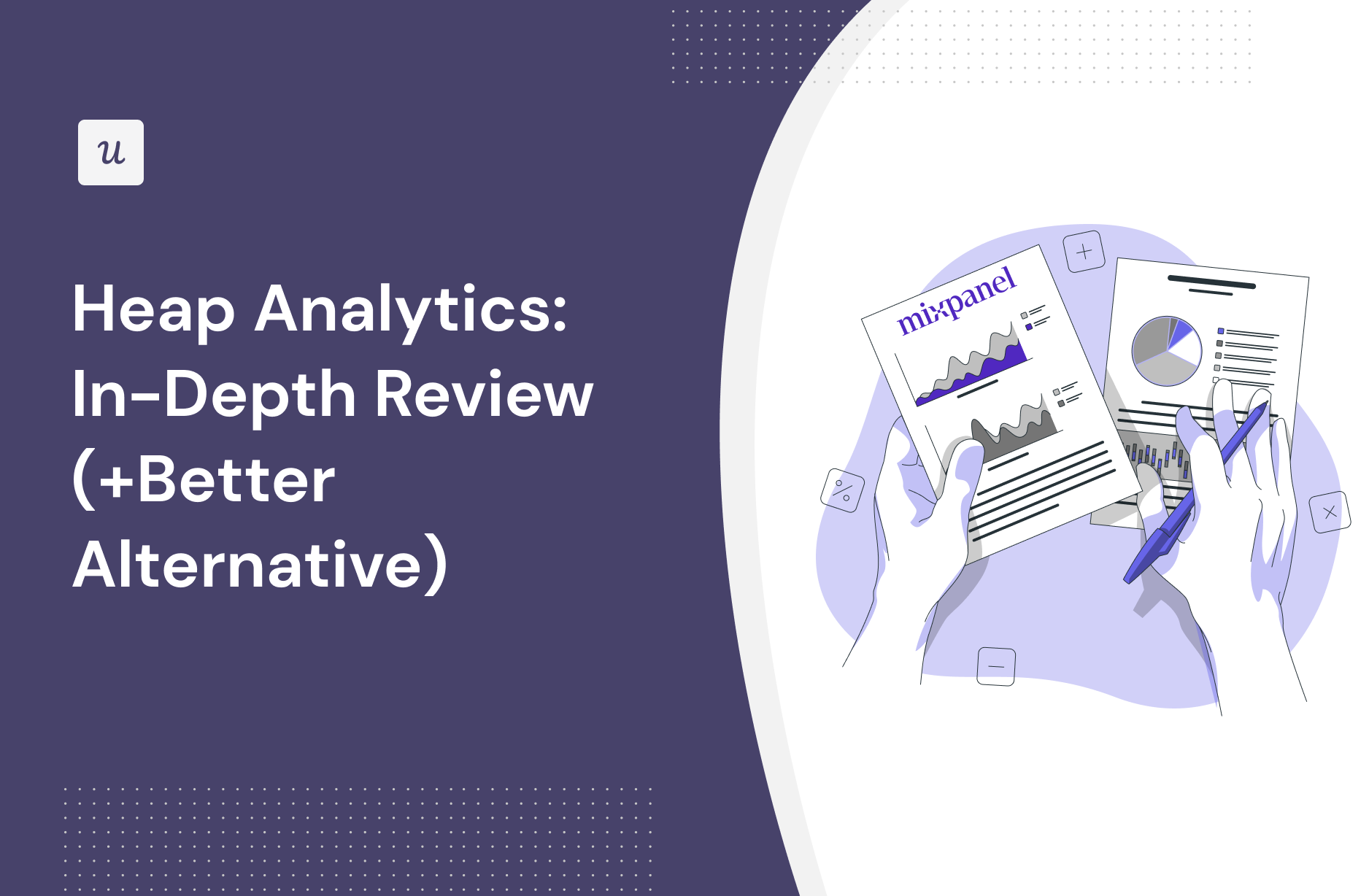
How useful is Heap analytics for product teams?
This is the key question we tackle in the article, so if you’re after the answer, look no further!
Ready to dive in?
Get The Insights!
The fastest way to learn about Product Growth, Management & Trends.
What is Heap product analytics?
In short, Heap is a product analytics platform.
It allows customer success teams, marketers, and product managers to track user interactions with the product across all touchpoints in the user journeys.
Thanks to the data, product teams can gain a better understanding of their needs and make data-driven decisions to improve conversions, and retention and deliver experiences that delight customers.
What data does Heap collect?
Heap enables teams to collect, analyze, and visualize complete data about all aspects of user experience inside the product.
With heap, you can track:
- User actions like clicks, forms submissions, hovers, downloads,
- Screen and page views,
- User properties, like demographics device type,
- Conversions,
- Acquisition data like sources of traffic.
Where Heap analytics stands out is automatic data collection so users don’t have to tag any events or features. Thanks to that, you can analyze event data retrospectively even if you didn’t think you would need to do it initially.
Overview of Heap’s functionality
So what analytics functionality does Heap offer? Let’s look at some of its flagship features.
Journey analysis for tracking user interactions
Thanks to the Journeys features, product teams can visualize and analyze all the paths that users take on the customer journey.
What are the use cases of the feature?
- By comparing conversion rates of different paths, you can use identify happy paths inside the product. If you know the most optimal path leading to activation and adoption, you can guide your users along.
- You can also find unhappy paths that are marred by high friction and drop-off rates. In this way, you can optimize them to improve conversion rates and retention.
- Journeys enable you to test the impact of new features and product changes on conversion rates and customer success.
Segmentation for understanding user behaviors of different groups
The odds are that your user base is not uniform. Instead, it consists of different groups with unique JTBDs, needs, and preferences.
Heap’s segmentation features allow you to group your customers so that you can better understand their needs and wants, and deliver personalized product experiences.
You can also use it to exclude certain data sets from the analysis so that your results are valid and reliable. For example, you could filter out your internal users, like employees, or bots.
With Heap, you can segment users by:
- Event data – for example, how many times or how often they completed an event within a specific time-frame
- User properties – like demographics or IP addresses
Session replay for understanding users’ experience
Session replays allow you to carry out an in-depth analysis of users’ interactions with a particular product page or screen.
To do so, you simply record what users do while engaging with the products as if it was a film or animation. Once you have the recording, you watch it and analyze user interactions to identify friction points and optimize the UX.
With Heap, you can filter the replays by
- Events – for example, sessions when users completed a specific event,
- Users – for example, users with a specific role in their company,
- Date ranges – for example, sessions from the last week or between two specific dates.
Pros and cons of Heap digital insights platform
As a product analytics platform, Heap has a number of strengths:
✅ A comprehensive range of analytics and reporting features that allow you to gain insights into different aspects of user behaviors.
✅ Automatic data-capture which doesn’t require tagging so that you can analyze it all retrospectively when the need arises.
✅ Real-time data tracking so you can respond immediately or trigger event-based experiences.
✅ Support for web- and mobile-based products.
However, Heap’s advantages can also be its downsides:
❌ Steep learning curve – because of the advanced features it offers, Heap is also difficult to learn.
❌ High data storage costs – you have to store all the data you collect, whether you need it or not.
Try Userpilot: A Better Alternative to Heap

What do users say about Heap?
Heap boasts a solid 4.3/5 rating on the review site G2.
Its users value its UI, automatic data collection, and in-depth analytics reports with granular insights into user behavior which enables informed decision-making.
For example, here’s what Jonas, a product manager has to say:
Heap has a very extensive and robust UI that enables you to dive deep into the data about how your users use your applications. The heat map and user journey features will allow you to see insights that are very hard to capture and visualize compared to other data analytics and visualization software. Heap takes much of the hard work required to centralize and visualize the data and provides critical insights into what product decisions you should make for your upcoming sprints.
However, not all users are as enthusiastic about Heap as Jonas. For example, Kelsey, a social media expert, mentions that the UI is not very intuitive for users who don’t specialize in data analysis. What’s more, Heap doesn’t always seem to cope with the huge amounts of data it collects:
…first, I don’t find it overly intuitive to use. As someone who works primarily in social media and copywriting, running data analyses isn’t my #1 skill,… so some of the more technical aspects of the tool make it seem unnecessarily complicated… Second, I’ve been hamstringed by queries simply not loading the data I need it to. I’ve reached out to CX about this and their response has been that there’s simply too much data for the query to run successfully…
Heap pricing
Pricing for Heap is available on request. You’ll have to contact the sales team for a quote. The final price will depend on various factors, including the number of sessions and integrations you need.
That said, Heap offers a free plan that lets you track up to 10,000 user sessions per month and stores your data for 6 months. Review platforms like G2 say that paid plans start at $3,600 per year. All paid plans come with a 14-day free trial, too.
You can choose from the following plans:
- Free – Ideal for teams looking to establish product-market fit.
- Starter – Suitable for startups looking to scale their business.
- Growth – Useful for companies that need advanced features, such as account analytics and report alerts.
- Pro – Tailored for enterprise businesses with robust security and compliance requirements.
It’s worth mentioning here that Heap offers a handy ROI calculator to help you get a clearer picture of whether it’s worth the investment.
Userpilot: A better alternative to Heap analytics
It was thought that Heap is the only digital insights platform that gives you a complete understanding of your customers’ digital journeys. However, with Userpilot you can get advanced analytics and feedback collection capabilities.
And it’s so much easier to learn than Heap.
Try Userpilot and Take Your Product Analytics to the Next Level

User funnel analysis for tracking customers’ digital journeys
Tracking user funnels is essential to getting a deeper understanding of the customer journey and reducing friction points. Userpilot helps you track user funnels by creating funnel reports, reviewing saved reports in bulk, and seeing key metrics like the average time it takes to complete a funnel.
Here’s how you can use Userpilot to generate funnel charts:
- Funnels: Userpilot’s funnel reports can show you the percentage of users that progress from one stage to another. Stages could consist of pages, actions, or other activation points. You can also set a specific order that these steps need to be completed or adjust the time period.
- Reports: The saved reports area of your Userpilot account lets you view, edit, duplicate, delete, or export (as a CSV file) all the analytics reports that you (or your teammates) have generated. You can also filter results by the teammate who created the report or the type of report.
- Duration: The granular funnel analytics can offer more insights into each stage of a particular user funnel, such as how long it took the majority of your users to complete it from start to finish. You can filter by time period and set minimum/maximum parameters to remove outliers.
A/B testing capabilities for experimenting with user flows
A/B testing is a crucial step in optimizing your flows and identifying the changes that provide the best response from your users. Userpilot’s native split-testing features let you confine experiments to a single page, track the downstream impact on goals, and customize any settings along the way.
Here are the Userpilot’s A/B testing features you can use to build experiments and analyze results:
- Page Targeting: The page targeting settings let you specify the domain and page that a particular A/B test should be triggered on. You can also add conditional triggers for experiments that should appear on any page where the criteria are met.
- Different types of experiments: You can run the classic A/B test using a control group, a multivariate test that tests two flows against each other for the same audience, or an advanced experiment in which you can set the conditions.
- Experiment goal: Track if the experiment was a success you can also connect it to an action goal to track impact.
- Experiment Settings: Userpilot lets you customize experiment settings to target specific audiences, adjust frequency, and decide when the experiment should be concluded. For instance, you could set a fixed number of days or continue the experiment until it gets results.
User path analysis for tracking the steps customers take
Userpilot’s Paths functionality, which will be available mid-September 2023, enables you to track every single step the user takes.
Just like Heap Journeys, you can use the feature to identify happy and unhappy paths, optimize customer journeys, and improve conversions by removing unnecessary friction.
Are you curious about the feature? Book the demo to find out more!
Segmentation for collecting actionable insights about user behavior
User segmentation is essential for creating a personalized and contextual onboarding experience. Userpilot can segment users based on demographics, product usage data, NPS scores, and more. You can then trigger flows or filter analytics based on segments.
Here’s an overview of Userpilot’s customer segmentation capabilities:
- Segment conditions: Userpilot lets you form segments by adding different conditions like user data, company data, features and events, etc. You can then use these segments as analytics filters or flow triggers later on.
- Analytics filters: Userpilot’s product analytics and user insights dashboards can be filtered to only display data from specific segments (or companies). This will help you extract insights from certain cohorts and compare how adoption or activation varies from one segment to the next.
- Flow triggers: Userpilot’s audience settings let you trigger flows for specific segments or target users that meet certain conditions. You can combine this with page-specific or event-occurrence triggers to show relevant flows to the right users at the most contextual moments.
- External data: Userpilot integrates with tools like Amplitude, Google Analytics, Mixpanel, and Segment using a one-way integration. This means you can use the data inside Userpilot to build advanced segmentation and trigger contextual experiences. For more advanced use cases, the two-way integration with Hubspot lets you send and receive data, unlocking a full set of use cases.
Custom events tracking for monitoring those with a high impact on conversion rates
Let’s imagine you’ve used the Paths feature to identify a number of events that are closely linked with user conversions. The occurrence of individual events doesn’t mean anything but when users complete them all, it indicates that they’re to upgrade to the paid plan.
With Userpilot, you can bundle the events up into custom events and track them as one. Whenever users complete the custom event, you could trigger an in-app message to prompt them to upgrade.
Apart from driving conversions and maximizing account expansion opportunities, you can use the feature to prevent churn as well.
Survey analytics for conducting sentiment analysis
Survey analytics are an essential part of extracting actionable insights from user feedback. Userpilot’s advanced analytics capabilities extend to any surveys you build with it. You’ll be able to see granular analytics for surveys, sort by audience or time period, and view NPS data separately.
Here’s an overview of the Userpilot features you can use during survey data analysis:
- Granular analytics: Each survey you create has its own analytics tab where you’ll be able to see which percentage of respondents chose a particular option, view the most popular choices, and review qualitative responses of users. You can also sort by segment, company, or time period.
- NPS dashboard: The dedicated NPS dashboard compiles survey responses to show you all relevant Net Promoter Score data in one place. This includes total views, NPS score, total responses, overall response rate, the number of qualitative responses, and how NPS is trending over time.
- User responses: Userpilot lets you review the responses of each individual user so you can see how sentiment differs on a customer-to-customer basis. This makes it easier to schedule follow-up interviews or implement suggestions made by users with the highest lifetime value (LTV).
Userpilot pricing
Userpilot offers flexible pricing based on your monthly active users (MAUs). Plans start at $299 per month for smaller teams and scale as your user base grows.
Below are the pricing tiers you can choose from:
- The Starter plan begins at $299/month (billed annually) for up to 2,000 monthly active users. It includes in-app user engagement, usage trend analysis, NPS surveys, and essential product analytics—ideal for mid-market SaaS teams getting started.
- The Growth plan starts at $799/month (billed annually) and adds advanced analytics, retroactive event auto-capture, in-app surveys, session replay, and more. It’s the most popular choice for growing teams that need deeper insights and scale.
- The Enterprise plan offers custom pricing and includes everything in Growth, plus bulk data handling, custom roles and permissions, SOC 2 Type 2 compliance, and enterprise-level support.

Get Advanced Analytics with a Better Value

Conclusion
Heap is one of the market-leading analytics platforms.
It offers a range of analytics features for granular analysis of user interactions with web- and mobile-based products.
However, it may be a bit challenging to use if you have limited experience in data science, and storing all the data it collects with advanced data science capabilities may be expensive.
Luckily, there is a better alternative that offers a complete dataset of analytics and helps you easily sort the data to optimize the entire digital experience of your users and improve customer delight.
If you want to see how Userpilot can help you achieve the same goals as Heap, book the demo!
Try Userpilot and Take Your Product Analytics to the Next Level








